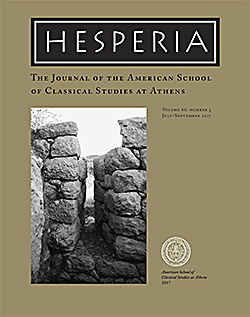Hesperia 86.3 Now Online!

The American School of Classical Studies at Athens is pleased to announce the publication of Hesperia 86.3. Topics in this issue include a review and analysis of the evidence for the origins of the Ionian cities of Asia Minor, a new interpretation of the Dipylon oinochoe graffito, the publication of a deposit of ostraka uncovered during excavations in the Athenian Agora in the 1990s, and new evidence for the dating of defensive fortifications in southwestern Anatolia based on the excavations of the Bastion complex on the Tepecik acropolis at Patara in southwestern Turkey.
Subscribers can read the issue online at JSTOR, which now hosts all current issues of Hesperia as well as an archive of past volumes.
Separating Fact from Fiction in the Ionian Migration, by Naoíse Mac Sweeney, examines the known evidence for the origins of the Ionian cities and finds that there was no one specific moment of foundation led by any one individual or group. Instead, the archaeological, historical, and linguistic evidence shows that the movement of people was gradual and likely disorganized. The author posits that the origin of a specifically “Ionian” identity coalesces in the 6th century B.C., representing the end point of a long process through which the Ionian identity was gradually formed over the Early Iron Age. An ambitious review of the works of over 100 ancient authors shows both how the myth was used to define or explain the Ionian identity and how it was referenced by others throughout antiquity when politically expedient.
The Dipylon Oinochoe Graffito: Text or Decoration, by Natasha M. Binek, provides a reexamination of the final segment of characters of the retrograde graffito written across the body of a Late Geometric oinochoe found near the Athenian Dipylon Gate. The first three-quarters of the inscription form a full hexameter, incised by an individual with some command of early letter forms in the 8th century B.C. The last six characters, however, have caused some debate. While some scholars have tried to see them as a continuation of the inscription, written in the hand of a second, less-literate individual, the author, from her recent personal inspection of the jug, sees evidence of a mirrored repetition of signs at the start of the inscription that was undertaken not to create words or form letters, but to extend the visual pattern of linear shapes so prevalent in Geometric-period decoration.
New Ostraka from the Athenian Agora, by James P. Sickinger, presents over 150 ostraka from the Athenian Agora that were found in an area east of the Classical Commercial Building in the late 1990s. A consistent fill suggested they belonged to a single, unified deposit that had been dumped at one time. The names of five candidates are represented, and the large number of sherds against Xanthippos indicate that the deposit dates to the years before the Persian War, perhaps to the ostrakophoria of 484 B.C. itself, the year of his ostracism. Through his analysis of the letter shapes, spelling, and other features of Attic writing found in the inscriptions, the author finds that most of the ostraka were written by individual citizens, thus providing additional insight into the status of Athenian literacy in the early 5th century.
The North Bastion on the Tepecik Acropolis at Patara: Dating “Early Hellenistic” Fortification Walls in Southwestern Anatolia, by Erkan Dündar and Nicholas K. Rauh, presents the results of the excavations of the North Bastion complex at Patara. Analysis of the masonry and construction technique shows that the Bastion was constructed in the mid-4th century by the Hekatomnids, a discovery that proves freestanding bastions preexisted Geländemauer fortification systems in southwestern Anatolia. Finds discovered in the Level IVa destruction level, which included evidence of a destructive fire and an inscribed sling bullet stating “Alexander, son of Philip,” indicate that the Bastion was likely assaulted by the forces of Alexander the Great in 334 B.C., an event that may be referenced by the author Arrian in his Anabasis.